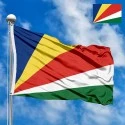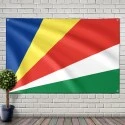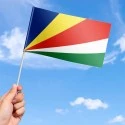The national flag of Seychelles is a visually striking and uniquely designed emblem that powerfully conveys the nation's aspirations for progress, unity, and its place in the modern world. Adopted on June 18, 1996, this flag replaced an earlier design, signifying a new era for the island nation and embodying the dynamic and forward-looking spirit of its people. Its distinctive pattern of converging colored bands is a metaphor for the diverse and harmonious society of Seychelles and its vision for a bright future.
Design and Symbolism: A Dynamic Convergence of Progress and Harmony
The flag of Seychelles features five diagonal bands of varying widths, originating from the bottom hoist (left) corner and fanning out towards the top and fly (right) edges. The colors are, from left to right, blue, yellow, red, white, and green. Each color and its unique arrangement carry deep symbolic meaning:
-
Blue: The blue band, starting from the bottom left, represents the sky and the sea that surround the Seychelles islands. It signifies the nation's deep connection to the Indian Ocean, its maritime heritage, and the vastness of its marine environment. Blue also embodies the desire for peace and harmony, reflecting the serene natural beauty of the archipelago and the peaceful coexistence of its diverse population.
-
Yellow: The yellow band, positioned next to the blue, symbolizes the sun that shines on the islands, a source of light, warmth, and life. It represents the prosperity and wealth of the nation, reflecting its economic growth, particularly through tourism and fishing. Yellow also signifies the vibrant and dynamic spirit of the Seychellois people and their aspirations for a flourishing future.
-
Red: The red band, following yellow, denotes the people and their determination to work for the future in unity and love. It represents the spirit of progress and revolution that has shaped the nation, acknowledging the struggles and sacrifices made for its development. Red is a powerful color that signifies the resolve and vitality of the Seychellois population in building a strong and unified society.
-
White: The white band, next to red, symbolizes justice, social harmony, and peace. It represents the rule of law and the purity of the nation's intentions to create an equitable and just society for all its citizens. White embodies the peaceful coexistence of the various ethnic and religious groups that make up the Seychellois population, highlighting the nation's commitment to dialogue and understanding.
-
Green: The outermost and largest band, green, represents the land and the natural environment of Seychelles. It signifies the nation's rich biodiversity, lush vegetation, and commitment to environmental conservation. Green is a powerful symbol of sustainability and the nation's pristine natural beauty, emphasizing the importance of protecting its unique ecosystems and abundant flora and fauna.
The diagonal arrangement of the colors, fanning out from a single point, symbolizes the dynamic and progressive nature of Seychelles, and how its diverse elements come together to create a unified and forward-moving nation. It conveys a sense of optimism and a future unfolding with growth and prosperity.
Dimensions and Proportions:
The official dimensions of the Flag of Seychelles are not strictly defined by a fixed ratio in all contexts, but commonly it is depicted with a width-to-length ratio of 1:2. The unique diagonal design means that the "bands" are not uniform in width along their length. Instead, they are defined by a specific geometric construction: they originate from a single point at the bottom-left corner of the flag and extend to specific points along the top and right edges. This creates a visually dynamic effect that is central to its symbolic meaning.
History and Evolution: From Colonial Emblems to National Identity
The history of the Seychelles flag reflects the country's journey through colonial rule to independence and subsequent political changes.
-
Colonial Flags (Pre-1976): As a British colony, the flag flown in Seychelles was the British Blue Ensign, defaced with the colonial badge of Seychelles. This badge typically featured a depiction of a giant tortoise (a native species) and a coconut palm.
-
First Independent Flag (1976-1977): Upon gaining independence from the United Kingdom on June 29, 1976, Seychelles adopted its first national flag. This flag featured two red triangles at the top and bottom (hoist and fly sides respectively) and a green triangle in the middle. These triangles converged at a single white stripe in the center. The red symbolized progress and revolution, green represented the land, and white symbolized peace and harmony. This design was chosen by the newly independent government under President James Mancham.
-
Second Flag (1977-1996 - One-Party State): Following a coup d'état in 1977 that brought France-Albert René's socialist government to power, a new flag was adopted on June 5, 1977. This flag consisted of a red upper half and a green lower half, separated by a wavy white stripe. Red represented socialism and revolution, green symbolized the land, and the wavy white stripe symbolized the ocean and the nation's unity. This flag remained in use throughout the period of the one-party state.
-
Current Flag (1996-Present - Multi-Party Democracy): With the reintroduction of multi-party democracy in 1993 and the subsequent general elections, a new flag was deemed necessary to represent the nation's changed political landscape and its renewed commitment to national unity and peace. The current flag, with its five diagonal bands, was officially adopted on June 18, 1996. This design was specifically chosen to symbolize a new era of multi-party democracy, reflecting the coming together of diverse elements (political parties, ethnic groups) to form a unified and progressive nation.
Regional Context and Island Nation Identity:
Seychelles is an archipelago nation located in the Indian Ocean, off the eastern coast of Africa. Its flag, while unique in its design, shares some thematic elements with other island nations and African countries. The use of vibrant colors like green, yellow, and red is common in African vexillology, often symbolizing natural wealth, sun, and the struggles for independence. However, the diagonal arrangement and the specific combination of five colors set it apart, making it highly distinctive.
The flag's emphasis on blue and green underscores the nation's profound connection to its marine environment and lush land, which are central to its identity, economy, and culture. Unlike many continental African flags that emphasize pan-African colors in horizontal or vertical stripes, Seychelles' flag uses them in a dynamic, fanning pattern, symbolizing its unique position as a small island developing state that values both its natural heritage and its progressive future.
Interesting Facts:
-
Third Flag in 20 Years: The current flag is Seychelles' third national flag since gaining independence in 1976, reflecting significant political shifts in its early post-colonial history.
-
Designed for a New Era: The 1996 flag was specifically chosen to represent the return to multi-party democracy and a spirit of reconciliation after a period of one-party rule.
-
Dynamic Design: The diagonal, fanning bands create a sense of movement and forward momentum, symbolizing progress and a dynamic future.
-
Rich Symbolism: Each of the five colors holds multiple layers of meaning, encompassing nature, economy, people, peace, and justice, making it one of the most symbolically rich flags.
-
Unique Arrangement: The diagonal arrangement of five distinct colors is rare among world flags, making Seychelles' flag instantly recognizable.
-
No Central Emblem: Unlike many flags that feature a star, emblem, or coat of arms, the Seychellois flag relies solely on its color scheme and geometric arrangement for its symbolism.
-
Focus on Environment: The prominent green band highlights Seychelles' strong commitment to environmental conservation, a crucial aspect of its national identity and economy.
Significance for the Inhabitants: A Canvas of Collective Identity and Shared Future
For the people of Seychelles, their national flag is a powerful and cherished symbol that encapsulates their collective journey, aspirations, and values. It is a visual representation of their unique identity as an island nation, where the stunning natural environment, represented by the blue of the ocean and sky and the green of the land, is integral to their existence and livelihood.
The dynamic interplay of colors, fanning out from a single point, resonates deeply with the Seychellois sense of community and the harmonious coexistence of diverse ethnic backgrounds. The yellow symbolizes the prosperity they strive for, while the red embodies the spirit of resilience and hard work that defines their national character. The white band is a constant reminder of the justice, peace, and unity that are fundamental pillars of their society.
The flag is proudly displayed during national celebrations, public events, and in schools, instilling a strong sense of patriotism and national pride. It serves as a unifying force, reminding all citizens of their shared heritage, their common goals, and their collective responsibility to work together for the continued progress and prosperity of their beloved islands. It represents a promise of a peaceful and abundant future, nurtured by the wisdom and spirit of its people.
In the demonstration images, full-size flags are shown with proportions of 2:3, and hand-held flags with proportions of 1:2.







 Waving flag
Waving flag
 Sizes:
Sizes:
 Round flag
Round flag
 Sizes:
Sizes:
 Rectangular flag 2:3
Rectangular flag 2:3
 Sizes:
Sizes: